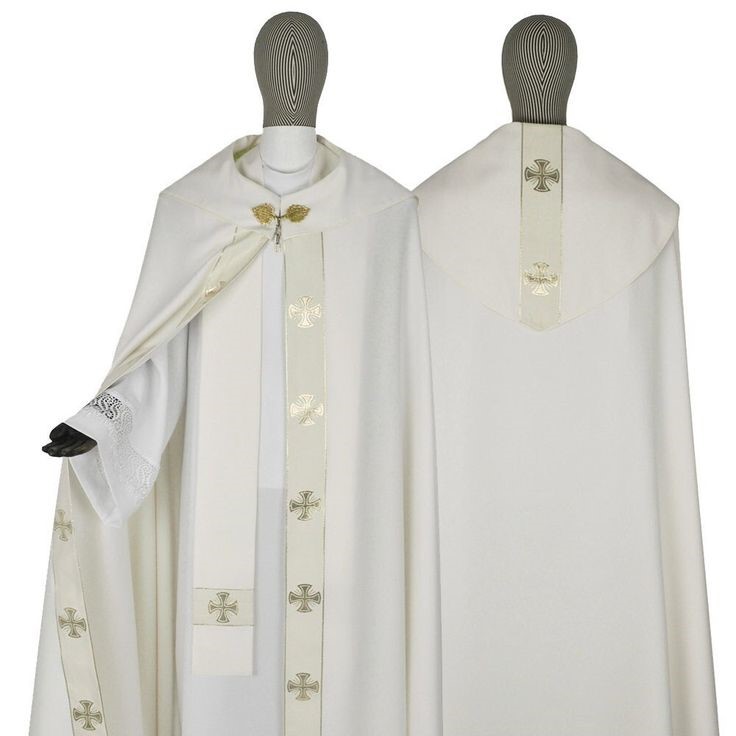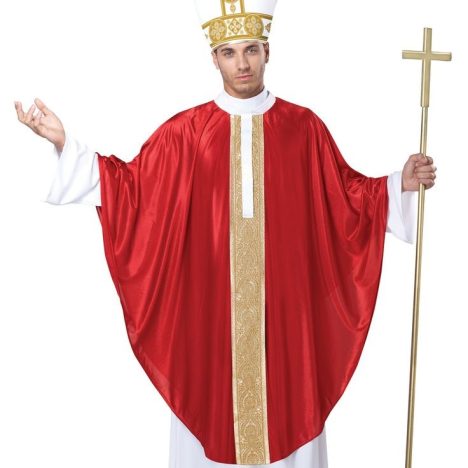Contents
- 1 The History of Papal Attire
- 2 Key Elements of a Pope Costume
- 3 Finding the Right Materials
- 4 Step-by-Step Guide to Assembling Your Costume
- 5 Accessorizing Your Pope Costume
- 6 Dressing for Different Occasions: Full Regalia vs. Simplicity
- 7 Maintaining Respect and Authenticity
- 8 Where to Buy or Rent a Pope Costume
The History of Papal Attire
Understanding the history of papal attire is essential when creating an authentic pope costume. The traditional clothing worn by the Pope has evolved over centuries. It reflects the significant role the Pope holds within the Catholic Church. Papal fashion dates back to the early days of the Church. Over time, certain elements have become symbolic.

One of the earliest and most recognizable pieces is the white cassock, which signifies purity and commitment to the faith. In the Middle Ages, the addition of elaborate robes and the Papal tiara came into play, representing authority and governance. The mozzetta, a short cape, also became a staple for outdoor events, signifying status. The traditional red shoes symbolize the blood of the martyrs and have been linked to the papacy since the early Church.
Each component is rich in meaning and history, making it important to consider these aspects when piecing together a pope costume. By acknowledging the historical significance of papal attire, one can create a costume that not only looks genuine but also respects the deep-rooted traditions of the Vatican and the Catholic faith.
Key Elements of a Pope Costume
When crafting an authentic pope costume, paying attention to key elements is vital. The costume is not just an outfit; it represents a rich heritage and holds deep significance in the Catholic faith. Here’s what you’ll need to include for authenticity:
- White Cassock: The heart of the costume; a long white robe symbolizing purity. It’s the most visible and iconic part of the pope’s attire.
- Papal Tiara or Mitre: Historically, the tiara was a triple-crowned headpiece, denoting authority. Nowadays, a mitre is more commonly worn. Either is essential for the headgear.
- Mozzetta: A small, elbow-length cape worn over the shoulders. It adds to the costume’s stature and signifies the pope’s role as a sovereign.
- Red Shoes or Loafers: Red footwear echoes the tradition linked to the martyr’s blood and signifies the historical lineage of the papacy.
- Pectoral Cross: A cross worn on the chest, often attached to a chain or cord, represents faith and dedication to the Church.
- Fisherman’s Ring: An ornate ring, it symbolizes the Papal tradition and St. Peter, the first Pope and fisherman by trade.
- Sash or Fascia: A decorative belt-like sash wraps around the waist, sometimes embroidered with the pope’s coat of arms.
Be sure to source quality materials that reflect the costume’s importance. With these elements in mind, you will be on your way to creating an ensemble that not only looks authentic but also pays tribute to the papal legacy.
Finding the Right Materials
Selecting proper materials is crucial for creating an authentic pope costume. The textures, colors, and quality will affect how genuine your costume appears. Here’s what to look for:
- Fabric for the Cassock: Choose a white fabric that drapes well. Linen or silk are good choices.
- Headgear Materials: Use sturdy materials for the tiara or mitre. Satin or velvet adds a regal touch.
- Mozzetta Texture: Velvet or heavy silk works well for the mozzetta to give it the right look of authority.
- Quality of Red Shoes: Leather is ideal for footwear, signifying the traditional aspect of the pope’s shoes.
- Metal for Pectoral Cross: Invest in a metal that has a shiny, authentic finish – gold or silver-tone metals are excellent.
- Ring Material: The Fisherman’s Ring should be a metallic and ornate, symbolizing its importance.
- Sash Fabric: Choose a fabric that can hold embroidery well, such as satin for the fascia.
Remember that each piece must be coherent with the rest of the attire. The materials should match in quality and color to maintain visual harmony. Look for suppliers that specialize in religious or historical costume materials for the best results. This attention to detail will make your pope costume stand out with its accuracy and commitment to authenticity.

Step-by-Step Guide to Assembling Your Costume
Creating an authentic pope costume involves careful assembly of all the key elements. Follow this simple step-by-step guide to ensure that your costume looks professional and respects the traditions of the papacy.
- Start with the Cassock: Lay out the white cassock, which forms the base of your costume. Make sure it is clean and well-pressed.
- Add the Papal Headgear: Choose either a papal tiara or a mitre. Place it securely on your head; it should fit comfortably.
- Drape the Mozetta: Put on the mozetta over the shoulders of the cassock. It should sit evenly and snugly.
- Wear the Pectoral Cross: Attach the pectoral cross around your neck so that it hangs prominently on your chest.
- Slip on the Red Shoes: Choose a pair of red shoes or loafers. Ensure they are polished and complement the overall look.
- Place the Fisherman’s Ring: Put the ring on the finger traditionally associated with papal authority. Often, this is the ring finger of the right hand.
- Tie the Sash: Wrap the sash or fascia around your waist. It should be snug but not restrictive, allowing you to move freely.
By carefully following these steps, you will have assembled a pope costume that not only looks authentic but also brings the rich heritage of the papacy to life. Remember to review each component for quality and proper placement to achieve the best possible effect.
Accessorizing Your Pope Costume
Once your pope costume is assembled, accessories add the finishing touch. They hold great importance in completing the authentic look. Here are essentials to consider:
- Papal Ferula: A staff often carried by the Pope during ceremonies. Look for one with a cross on top.
- Stole: A long, narrow band of fabric that drapes over the shoulders. It signifies the Pope’s authority.
- Cincture: A cord used to tie around the waist over the cassock. Traditionally, it is white or gold.
- Zucchetto: The small skullcap worn by the Pope. It is typically white to match the cassock.
- Pallium: A woolen band worn over the shoulders with crosses. Seek an authentic design.
- Rosary: The Pope is often seen with a rosary. Choose one with a simple, elegant design.
- Cape or Mantum: For colder climates or formal events, this long cape adds solemnity.
Each accessory should reflect the tradition and dignity of the Pope’s role. Make sure they all match in color and style, with attention to quality. These details contribute greatly to the authenticity of your pope costume.
Dressing for Different Occasions: Full Regalia vs. Simplicity
When donning a pope costume, it’s important to consider the occasion. Different events may call for varying degrees of formality in papal attire. For a full regalia look, you’ll incorporate all the traditional elements. This includes the intricately designed cassock, opulent mitre or papal tiara, and the richly ornamented accessories. Full regalia is ideal for grand events where historical accuracy is key.
In contrast, for more casual or low-key events, simplicity is appropriate. You might choose a basic white cassock and simple mitre, skipping the more elaborate accessories like the pallium or ferula. The aim is to maintain the essence of papal dignity without the full display of pageantry. This approach can be respectful and suitable for educational roles or less formal gatherings.
No matter the occasion, remember to keep the costume respectful and accurate. Even a simplified version should align with the traditions and significance of the Pope’s role. Strike the right balance between detail and context to ensure your pope costume is fitting for the event.
Maintaining Respect and Authenticity
While crafting a pope costume, respect and authenticity are key. These principles guide not only the selection of materials but also how the costume is worn. Showing appropriate respect honors the significance of the papal role in the Catholic tradition.
- Study Religious Significance: Understand the meanings behind each item of the pope’s attire. Knowledge adds depth to your representation.
- Context Matters: Always consider the setting in which you will wear the costume. Adapt the elements of the costume to suit the occasion, ensuring it is always respectful.
- Avoid Stereotypes: Focus on historical accuracy rather than clichéd or exaggerated versions. Each piece should accurately reflect its traditional significance.
- Interact Appropriately: When wearing a pope costume, embody the dignity associated with the Pope’s position. Avoid frivolous behavior that could be seen as disrespectful.
- Consult Experts: If possible, consult with historians or religious leaders. Their insights can help you achieve both accuracy and respectfulness.
Following these tips will help ensure that your pope costume respects the tradition it represents. It will also enhance the authenticity of your depiction. Remember, the goal is to pay homage to a rich cultural and religious heritage.

Where to Buy or Rent a Pope Costume
Finding the perfect pope costume can be a breeze if you know where to look. Whether you choose to buy or rent, there are a few options you should consider. Here’s where you can start your search for that authentic-looking attire:
- Specialty Costume Shops: These stores often carry a range of religious costumes, including those for the pope. They may offer both buying and rental options.
- Theatrical Costume Suppliers: They provide high-quality outfits perfect for productions or events where authenticity is crucial.
- Online Retailers: Many online stores specialize in costumes, and you can filter your search for religious or pope-themed outfits.
- Religious Supply Stores: Some stores focus on religious garments and may offer pope costumes or custom orders.
- Rental Services: Look for costume rental services that can mail you the costume for your event with return instructions included.
Remember to check the quality, materials, and accuracy of the costumes available. Read reviews and possibly consult with experts to ensure the outfit meets your needs for authenticity and respect. By searching these sources, you’ll likely find a pope costume that fits well with your portrayal, keeping in mind the tradition and significance of the papal attire.
